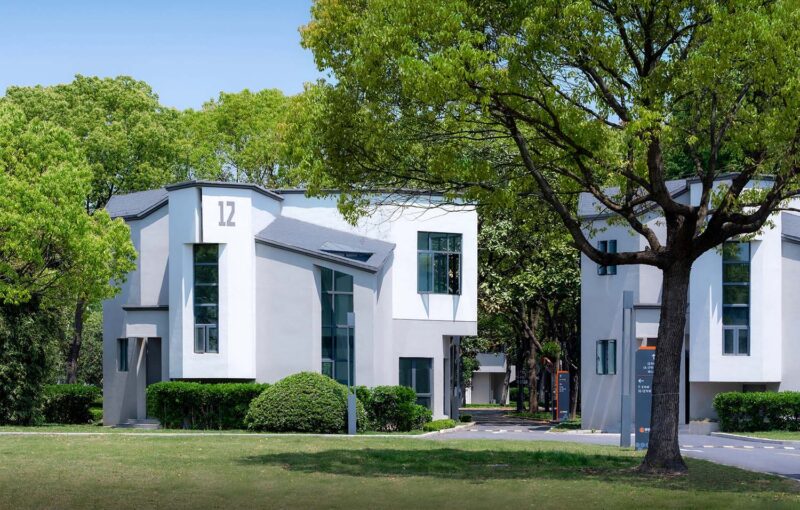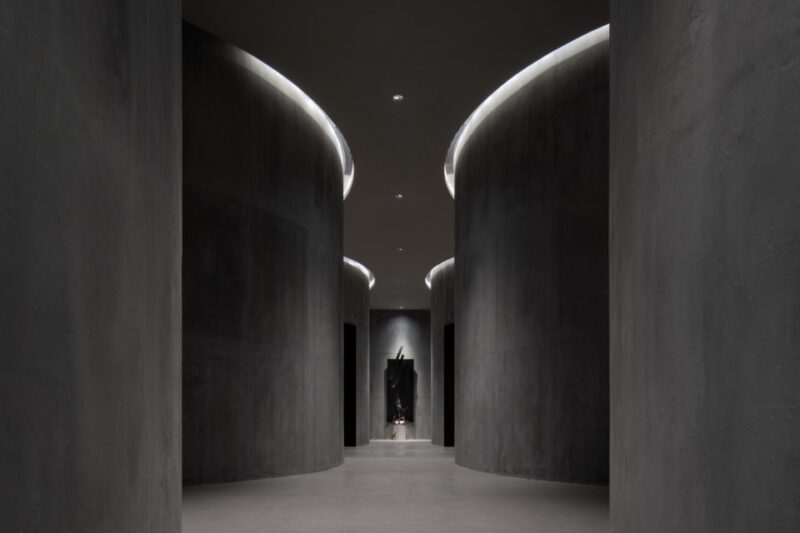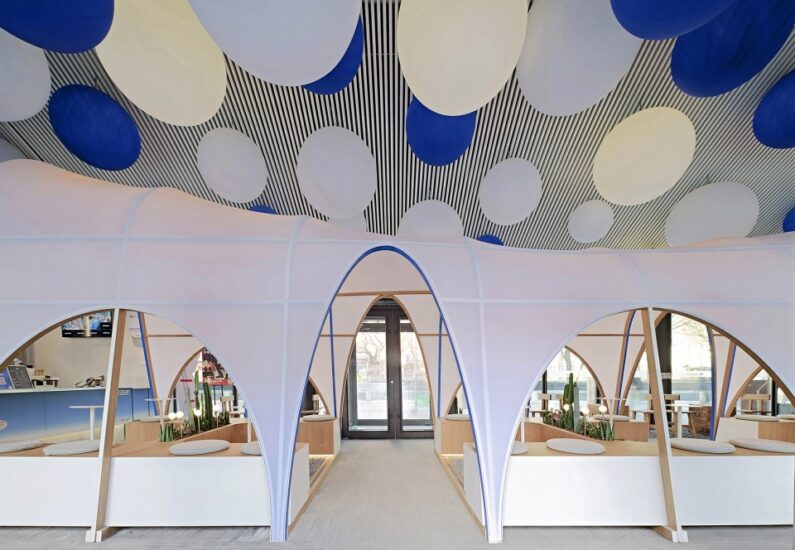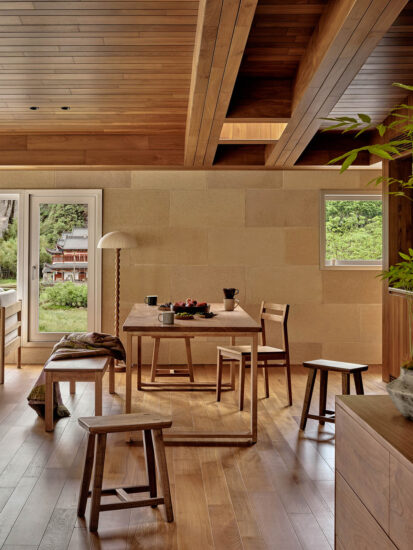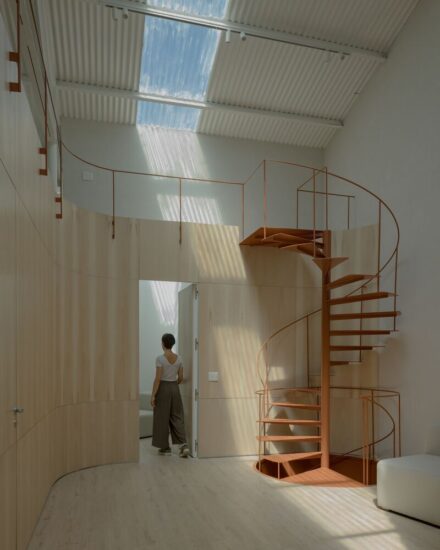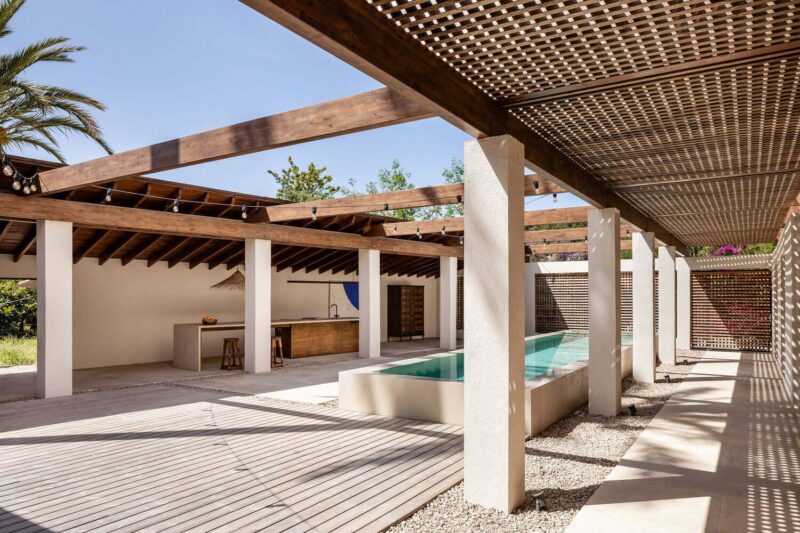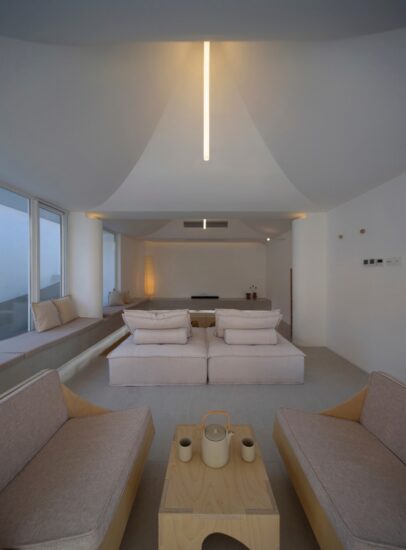全球设计风向感谢来自予舍予筑 (Yushe Design)的民宿兼自宅改造项目案例分享:
田园乡村是根植在每个中国人心底最深刻的浪漫。这种“浪漫”在城乡差异持续拉大而造成的“永远回不去的故乡”的现实渲染下,愈发强烈。在喧嚣嘈杂的城市生活中,土地资源稀缺而昂贵,若能在田园间拥有一处宅院,与清风朗月为伴,与志趣相投的好友置酒言咏,真的是“终日不倦”。尤其是随着年龄渐长,越发觉得“白的花胜似绿的叶,浓的酒不如淡的茶”,对无价值可衡量之物更加珍惜,明月清风本不用一钱买,世间好物似乎总在质朴的乡村生活中才能得到最本真的还原。
The return to pastoral life has long been an ideal of Chinese literary tradition, it is the most romantic way of living deeply rooted in each Chinese’s heart. With the rapid globalization and urbanization, the desire turned into “xiangchou”— a term that refers to nostalgia for rural lands and the hometown that cannot be return for those earned their livings in big cities. Compared to city life Especially when growing older, country life restores the purest parts of life. For the urbanite, country life must be the ultimate escape from the hustle and bustle of city life, just like the famous saying goes:” White flowers are better than green leaves, while strong drinks are not as good as mild tea.”
项目背景:老宅之本
Background : the original site
在长兴县西南部的周吴岕村,整个村庄依山傍溪而筑,东临雉城镇,西毗泗安长潮岕,北与“十里古银杏长廊”八都岕隔山相望。村中有一座百余年历史的老宅,宅子早在1898年由主人周安生耗费15年修建完成,周姓家族遵循着“唯勤劳才有饭吃”的家规和“积善行德、平安百年”的家训,子孙后代遍布海内外,而唯独这座老宅因长久无人居住而风雨飘摇,只剩下庭院前的红梅每年冬天自顾自地绚烂。故事缘起于委托人作为其中一位周家子孙,不忍看着这样一座祖宅就此逝去,于是联合众兄弟姐妹,试图将其打造成一个静心而居的民宿兼自宅,这便是老宅新生最终的得名由来“安生斋居”。
Named the Ancestor House, the property was the family mansion first built in 1898 by Zhou Ansheng, the grandfather of the client who tasked Yushe Design for the project. However, the house has been largely derelict for decades since all the family members left hometown for better living. One of his offspring’s nostalgia for the countryside and childhood couldn’t bear to leave it abandoned, so he tasked Yushe Design to restore and renovate it into a boutique hotel with a suite for the family.
我们初次踏勘项目地时正值寒冬,徽派建筑的门头上“积善流芳”的字迹业已模糊不清, 即便如此,局部坍塌的老宅在枯树在杂草的衬托下,竟和自然十分和谐。建筑主体属于典型的穿斗式木结构,外部墙体做法为中国历史悠久的夯土墙技术,从局部坍塌的墙面内部还能看到暴露出的一根根水平方向的竹制“墙骨”。周先生对传统建造技术有着很深的情结,对老宅的感情之深可见一般。设计充分尊重了他的情感记忆,以“自然营造”为总体策略,不增加不属于场所本身的体量或装饰,尽量减少对自然环境和乡民的生活影响。对保存完整的徽派建筑风格老墙及穿斗式木结构进行复原修葺,对坍塌严重部分引入新结构,使老建筑与新结构交相呼应。拆下来的旧木料、旧砖瓦、花瓶式柱础都将被重新被利用,老宅内的古树根据景观布局进行移植栽种。
When we first visit the site, the house was surrounded by weeds and shrubs, and blossomed red plum. Ancient villages in Zhejiang Province are always in some sort of inherent harmony with nature. The original building was a traditional Chinese courtyard dwelling — three-hall structure with two wings and four internal courtyards, with the main structure of through type timber frame. Except for the characteristic Huizhou-style facade and roof which are well preserved, most of the other original features — the loam walls, wooden roof trusses, timber beams and columns, grey tiles are severely damaged. Under such condition, the building might seem to be of little value to some villagers, but for Zhou’s family, it is a century-old dream and memory. And for us, it was just like an uncut jade to be carved into great works.
We think the best solution to rural revitalization would never be building new houses over old ones, not to mention undisciplined occupation of land. The most appropriate yet difficult way of Chinese rural construction is one that makes people feel at ease in the space without deliberate interference nor imitation of the ancient, as described by a famous saying in Tao Te Ching by Lao Tzu: “ A great sound is inaudible, and a great image is formless.
As a result, the original structure of Huizhou-style façade and walls were revamped and reinforced by steel-concrete structure so as to eliminate air/wind leakage and potential structural risks. The severely damaged through type timber frame were rebuilt according the original structure. Some undamaged beams and stone plinths under the wooden pillars were kept intact, the demolished ones such as grey tiles are recycled for pavements and decoration, echoing the history to the house and the local culture on the tectonic side as well as showing sustainable ecological construction philosophy.
设计过程:隔世回响
Design Phase: a century response
林语堂先生在台北自宅中写了《不亦快哉二十四则》,其中有对理想宅院的描述:宅中有园,园中有屋,屋中有院,院中有树,树上见天,天中有月。不亦快哉!庭园古往今来便是中国文人所向往的住宅。在本案的设计中,我们几乎完全延续了原建筑外部的建造特征,外立面的徽派老墙头也得以完整地保留。叩开这扇老木门上的兽面衔环辅首,一个自己仿佛与另一个自己在光阴里隔世重逢,一个世纪的记忆在周家人心中发出深厚而温润的回响。
Famous Chinese writer Lin Yutang, also best known is the West for his English writing once described his ideal home:“Garden within a house, house within a garden, courtyard among rooms, trees among courtyard, sky above trees, moon in sky”, reflecting the most distinctive feature of Chinese home design of all ages is the stone-paved courtyard, just similar in effect to a Spanish cloister, and symbolizing peace, quiet and repose. Courtyards are spiritual place for Chinese ancient literati, and still a longing place for urbanite where they can be assured of being personally pampered in beautiful rural surroundings to get away from the hustle and bustle.
对空间的划分组织依然沿用旧有“三进三开”的合院布局形制,并强化了原有传统材料的形式秩序。14间客房沿建筑外侧布局,穿插若干景观庭院,保证每间客房良好的景观视线的同时,留出大量的公共空间满足现代生活所需。旧有庭院住宅最大的劣势是采光,因此我们将局部墙体以玻璃幕墙替代。围合的是私密的空间,通透的是公共空间,静谧开合,院落、长廊、一花一草一木互为景致,体现层次和意境。四季五感,只在这一亩三分地之中都可看尽。韩愈笔下那句“白雪却嫌春色晚,故穿庭树作飞花 ”或许就是在这样的庭园中才有感而发的。
We made it a priority to restore and repair the existing building, keep the original spatial layout, revive the sense of sophistication and stateliness that existed when the original property was first built, an ode to its past. The back hall connects the two floors and with an exquisite wooden stair and provides access and privacy for all the 14 rooms. The disadvantage of traditional courtyard dwelling layout is insufficient of light, thus a side wall of the lobby had to be replaced by glass screen walls to bring in light. The transparence also enhanced the connectivity between the indoor spaces and the open courtyard. No wonder a beautiful poem like “ The white snow/ vexed by the late coming of spring’s colors/ Off set purpose darts among the courtyard’s trees to fashion flying petals”, would be written in such artistic courtyard.
沿着主入口的一排毛石矮墙拾级而上便进入了周家老宅。通过毛石、沙砾、以及废弃的小青瓦用于不同区域的地面铺装,以少量的绿植来创造“半山、半石、半绿”的留白意境。无需明确的界定,院墙、绿植、地面铺装就已经为空间做出了区分,让室内与户外空间在自然四季变化中自然转换,在有限的空间中创造多样的游走序列。
Stepping into the lobby through the low robust rubble wall and a stone-paved courtyard embellished with two local red plum trees, the exploration now starts. In Chinese paintings, blank-leaving is highly valued, we call it “half-half” way. The two courtyards divide the spatial patters and create various circulation route, providing a playful walking experience as well as impressive views.
穿斗式木结构集中在大堂复原,古老而幽深的木色配合少量柔和的灯光更显空间的深邃,一种时空交叠的体验。大堂地面的青石板就地取材,尽量保留原始建筑及当地文化气息。当室内设计的细节完全与环境相融时,装饰也便不是矫饰,而成为了环境的一部分,成为物质它自身。大堂内部,玻璃幕墙和木质格栅的运用让整个空间更加通透开放。室内采光良好,只需极少量的灯具点缀。
客房区室内装饰以原木色为主色调,墙面采用颗粒涂料强调新与旧的对比。我们对于某些所谓的“极简主义”室内设计保持怀疑,尤其是在酒店客房中所出现的水泥材料。而木材则有自己的记忆,会随着时间呼吸,每个阶段都有不同的色泽,它简单、质朴、有温度,给入住者带来家一般的温暖。
The family-style setup is perfect for those who want quietude, away from the bustling city. The interiors consist of two ideas, simplicity and space. We brought in few pieces of furniture with simple lines, good quality and extremely polished, which perfectly fuse different hues and texture. Wooden grills and local limestone floor emerged together to create a sense of warmth, naturalness. The new reflects the past without imitating it.
客房后院有银杏、红梅等丰富的植被,住户可由此上山体验乡野乐趣。今年冬天,后院的柿子比往年结的都更丰硕,明明枝干都已苍然秃颓,可红色如染的柿子却耀眼动人。就像是鲁迅笔下那颗做着“小粉红花的梦”的枣树,似乎知道秋后要有春,春后还是秋。山中岁月也全非杀鸡宰羊之类粗俗的烟火气,自然也有拈花把酒的诗情画意。
后记:时间的建筑
Architecture of time
人们常说 ,建筑是一门空间的艺术。但建筑,也是一门时间的艺术。—卒姆托
Architecture is a spatial art, as people always say. But architecture is also a temporal art. ——Peter Zumthor
从设计到建造,安生斋居的复原刚好历经两个四季轮回;从废墟到繁荣,周家人的老宅复兴梦延续了一个世纪。让一代人或几代人的温暖记忆再现、存续。往后,它将吸纳不同人们生活的轨迹,在当代生活中创造新的品质。
From design to construction, the restoration of Ancestor House just went through a cycle of four seasons; from ruins to prosperity, the Zhou family’s dream of reviving the old house continued for a century. Rather than an architectural and interior design, it is a shaping of the humanistic pattern of “etiquette”, and a modern rebirth of Chinese residence.
对于建筑师而言,我们的使命是终日平衡脑海中理想的山居生活空间与不那么饱满的现实的差距,以及乡村营造这一特殊语境下所需要处理的社会场景和情形。在本案中,乡村营造带给我们的思考一方面是科班出身的“专业”与乡村“无建筑师”这样的现实情况的撕裂。比如,我们最初希望将外立面的墙都以做旧的方式来粉刷,而当地工人一下就全给刷白了,而我们正统的“刻板”做法,也被当地村民嘲笑了好一阵。这种矛盾是每个从事乡村营造的建筑师都深有体会的。值得欣慰的是,当项目建成后,当地的许多村民开始对于自建房屋的改造有了新的认识,而在“美丽乡村”、“乡村振兴”的大背景下,类似的项目一定会越来越多,帮助农村经济的振兴,从而让更多城市的人回流,空心村的现状得到缓解。
There were always gaps between the ideal of design and the reality of the craftsmen’s experience and techniques, for example, at first, we would like to do antique finish of the facade wall to show the history of the house, but with several rounds of negotiation and mutual compromises, it turns out to be fresh white. The “architecture without architects” in rural areas has revealed a specific situation where it was very hard for architects with trained ways of thinking to truly “root” himself in the village, for his trained experience was not necessarily what was needed there. Anyway, for our design team, this project was a most thorough practice of our “buildingless” approach. The completion of the project hasn’t left a sign of new building on the village, but the landscape at the village entrance, the alleys around the house, and the interior and exterior spaces of the building, were all more harmonious with the people’s life and the village, and more friendly to visitors from outside. This project has also inspired some local villagers thinking of renovation of their own house. in-depth thinking in us.
In the context of China’s “beautiful villages” and “village rejuvenation”, Changxing, as one of the main positions for the revitalization of the rural areas in Zhejiang Province, has been formulated in various aspects such as strengthening capital investment, housing system reform, and rural human settlements. With nearly 40 supporting policies and measures, we have reason to expect this new model to attract interesting people to gather, nourish the rural ecology and develop healthily. We believe, lots of characterful country house hotels would follow.
主要项目信息
项目地址: 湖州市长兴县周吴岕村
建筑面积:1202㎡
建筑、室内、景观设计:予舍予筑 (Yushe Design)
主持建筑师:陈潇、李志强、许异、高善通
建筑设计团队:李娜、庞迪、梁修柱
室内设计团队:毛莉丽、陈鹏、赵西康
景观设计团队:郁浩艳、陈静峰、马江
木结构深化设计及施工:上海隽执建筑科技有限公司(JAZBUILD)
设计周期:2017.3-2018.7
施工周期:2017.11-2019.11
摄影:Fancy Images
Project Location: Zhouwujie Village, Changxing County, Huzhou City, Zhejiang Province
Floor Area:1202㎡
Architecture & Interiors & Landscape Design: Yushe Design
Principal Architect:Chen Xiao、Li Zhiqiang、Xu Yi、Gao Shantong
Architectural Design:Li Na、Pang Di、Liang Xiuzhu
Interior Design:Mao Lili、Chen Peng、Zhao Xikang
Landscape Design:Yu Haoyan、Chen Jingfeng、Ma Jiang
Timber Frame Design and Construction: JAZBUILD
Design Phase:2017.3-2018.7
Construction:2017.11-2019.11
Photography:Fancy Images





























